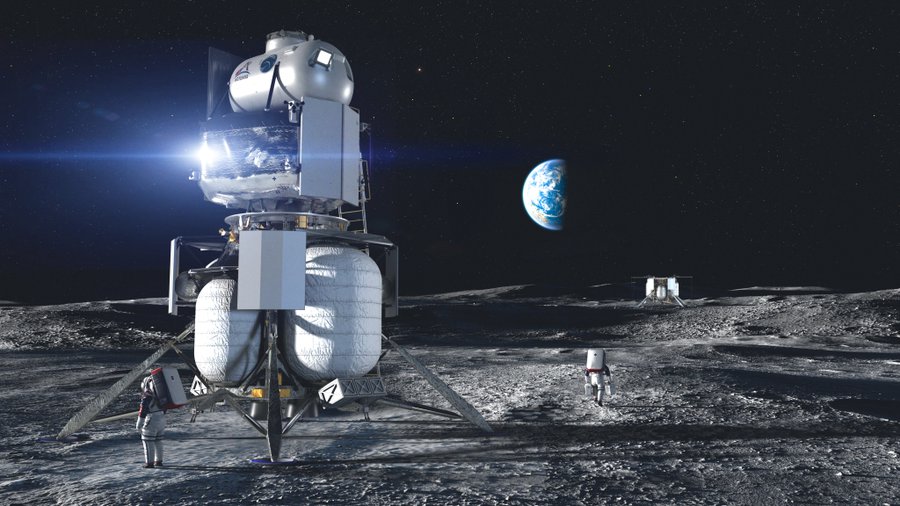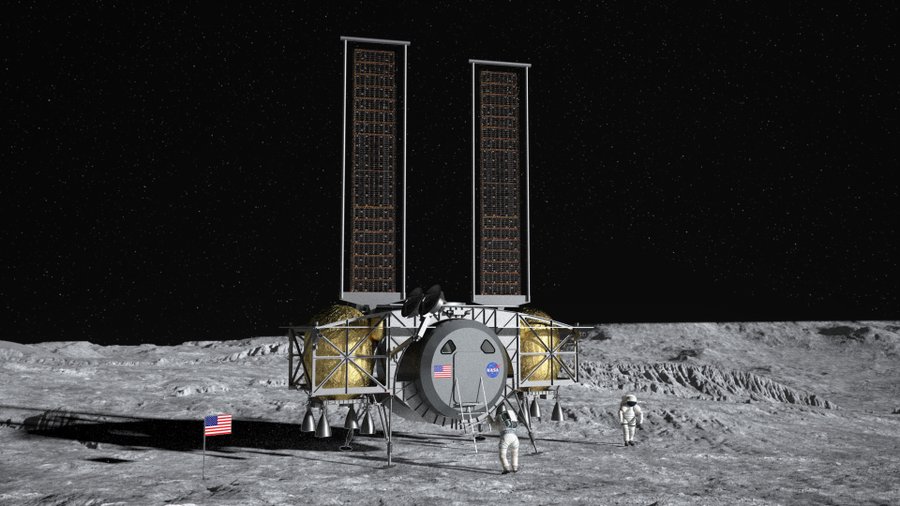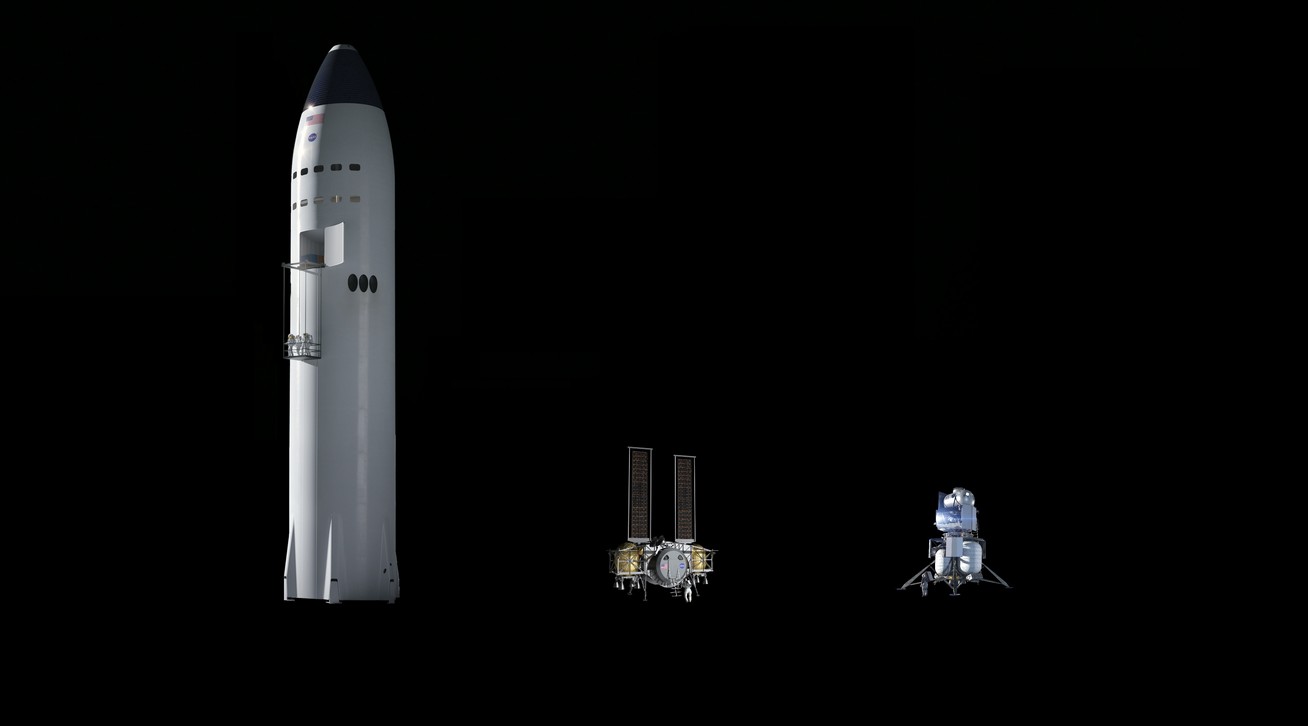This video is from the NASA website.A few comments at the beginning.1. : , , «», , , , .
2. «» , .
3. , , — , .
4. , .
5. .
So let's go. It all started with a tweet from NASA administrator Jim Bridenstine that appeared at night:And the next three “picture tweets”: @BlueOriginis the prime contractor for the “National Team” that includes @LockheedMartin, @northropgrummanand @DraperLab. The team's design is a three-stage lander that harnesses the proven spaceflight heritage of each team.
@BlueOriginis the prime contractor for the “National Team” that includes @LockheedMartin, @northropgrummanand @DraperLab. The team's design is a three-stage lander that harnesses the proven spaceflight heritage of each team. @Dynetics is working with a robust team of more than 25 subcontractors. Their two-stage lander concept includes a single element with ascent / descent capabilities and a unique crew cabin that sits low to the Moon's surface.
@Dynetics is working with a robust team of more than 25 subcontractors. Their two-stage lander concept includes a single element with ascent / descent capabilities and a unique crew cabin that sits low to the Moon's surface. TheSpacexhuman lander design is a single-stage solution with Starship, their fully reusable launch and landing system designed for travel to the Moon, Mars and beyond. The proposal included an in-space propellent transfer demonstration and uncrewed test landing.Now we’ll carefully read the tweet about SpaceX’s participation:“Manned LandingSpacexis a one-stage Starship ship, fully reusable and designed to travel to the moon, Mars and beyond. This proposal included a demonstration of the delivery of fuel into space and a test landing (on the moon) in automatic mode. ”In fact, "to the moon, Mars and beyond" is somewhat inaccurate. It is the Starship that will be used as a lunar lender that will never return to Earth, therefore it does not have “wings”.But the most interesting thing in this tweet is the last sentence - if everyone else makes only a landing page, then SpaceX must ensure delivery of fuel into orbit (near moon?) And demonstrate refueling the ship with liquid oxygen and methane, i.e., cryogenic liquids. Later it turned out that these were only the first surprises.But for starters, one more funny picture:
TheSpacexhuman lander design is a single-stage solution with Starship, their fully reusable launch and landing system designed for travel to the Moon, Mars and beyond. The proposal included an in-space propellent transfer demonstration and uncrewed test landing.Now we’ll carefully read the tweet about SpaceX’s participation:“Manned LandingSpacexis a one-stage Starship ship, fully reusable and designed to travel to the moon, Mars and beyond. This proposal included a demonstration of the delivery of fuel into space and a test landing (on the moon) in automatic mode. ”In fact, "to the moon, Mars and beyond" is somewhat inaccurate. It is the Starship that will be used as a lunar lender that will never return to Earth, therefore it does not have “wings”.But the most interesting thing in this tweet is the last sentence - if everyone else makes only a landing page, then SpaceX must ensure delivery of fuel into orbit (near moon?) And demonstrate refueling the ship with liquid oxygen and methane, i.e., cryogenic liquids. Later it turned out that these were only the first surprises.But for starters, one more funny picture: These are all three of NASA's proposed landing pages on the same scale.
These are all three of NASA's proposed landing pages on the same scale.More details here:NASA said Blue Origin’s contract is valued at $579 million, and Dynetics will receive $253 million for the 10-month contract base period. That money covers just the first phase of a multi-year lunar lander development effort that NASA predicts could cost $18.4 billion through the end of 2024.
Each commercial lander contractor team is expected to provide private funding to support lunar lander design and development.
The $135 million contract with SpaceX marks the most significant government investment to date in SpaceX’s Starship system, but Blue Origin and Dynetics won larger lunar lander contracts from NASA.
“Looking at the different (HLS) contractors, each one of them is very different,” Bridenstine said. “Some of them are likely to be more interested in going fast, others are more likely interested in creating the breakthrough technologies that are going to drive down cost and increase access.”
“SpaceX proposed the Starship,” Bridenstine said. “It’s obviously a very different solution set than any of the others. But it also could be absolutely game-changing. So we don’t want to discount it. We want to move forward. If they can have success, we want to enjoy that success with them.”
https://spaceflightnow.com/2020/04/30/blue-origin-wins-lions-share-of-nasa-funding-for-human-rated-lunar-lander/ Thus, for the first ten months, Blue Origin will receive a contract of $ 579M, Dynetics for $ 253M, and SpaceX $ 135M, which will be the first major government investment in Starship.A set of documents for the program In general, SpaceX is supposed to demonstrate Super Heavy (this is the “first step” for Starship), a long orbital flight, an in-orbit fuel depot (refueling) and the ability to transfer cryogenic fuel in zero gravity, and an unmanned vehicle to land on the moon in 2022. At the same time, NASA does not buy Starships, but only orders services that are rendered with their help. Mask has a whole fleet of Starships:One Starship-Lender.One Starship-tanker NOO-lunar.One Starship Depot at the DOE.At least two Earth-DOE tankers.We recall the second spaceport, two more tankers,one, rather two, Starship for launching satellites, the same Starlink.One manned to fly around the moon in 2023 ...As a result, after the NASA astronauts landed and returned to Earth under the rumble of a timpani, the Starship bus with two dozen tourists will silently drive to the gas station, they will go to Starship Lender and go on a hike to places of military glory. From a distance of two hundred meters they will inspect Apollo’s landing sites from a porthole, stroll around Starship, standing on the moon. Maybe they’ll even be allowed to come closer and reverently kneel next to the footprints of the astronauts of the last century.So far, that's it for a start. Information will be updated with article upgrades and comments.